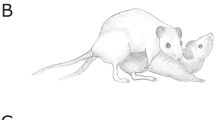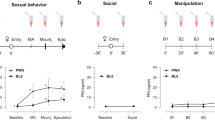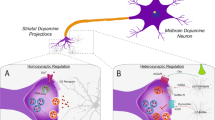Abstract
The use of the D1/D2 dopamine receptor agonist apomorphine SL for the treatment of erectile dysfunction provides a strong support in favour of a participation of the dopaminergic system in the control of sexual function. However, the exact involvement of dopamine in sexual motivation and in the control of genital arousal in humans is unknown. In contrast, experimental data suggest an implication of dopamine at all these stages of the copulatory behaviour in rodents. The release of dopamine at the level of the nucleus accumbens, which is innervated by the mesolimbic dopaminergic pathway originating in the ventral tegmental area, is positively implicated in the pre-copulatory or appetitive phase in male rats. There is also a permissive role in the copulatory or consumatory phase for dopamine released at the level of the median pre-optic area, which receives projection from the dopaminergic incertohypothalamic pathway within the hypothalamus. It is noteworthy that these participations of the dopaminergic system are not specific to sexual behaviour but rather reflect the more general involvement of dopamine in the regulation of cognitive, integrative and reward processes. Due to its role in the control of locomotor activity, the integrity of the nigrostriatal dopaminergic pathway is also essential for the display of copulatory behaviour. Somehow more specific to sexual function, it is likely that dopamine can trigger penile erection by acting on oxytocinergic neurons located in the paraventricular nucleus of the hypothalamus, and perhaps on the pro-erectile sacral parasympathetic nucleus within the spinal cord. The counterpart of such regulation of the genital arousal by dopamine has not yet been established in females. In conclusion, the central dopaminergic system is a key element of the control of sexual function.
This is a preview of subscription content, access via your institution
Access options
Subscribe to this journal
Receive 8 print issues and online access
$259.00 per year
only $32.38 per issue
Buy this article
- Purchase on Springer Link
- Instant access to full article PDF
Prices may be subject to local taxes which are calculated during checkout
Similar content being viewed by others
Author information
Authors and Affiliations
Corresponding author
Rights and permissions
About this article
Cite this article
Giuliano, F., Allard, J. Dopamine and sexual function. Int J Impot Res 13 (Suppl 3), S18–S28 (2001). https://doi.org/10.1038/sj.ijir.3900719
Published:
Issue Date:
DOI: https://doi.org/10.1038/sj.ijir.3900719
Keywords
This article is cited by
-
Omega 3 fatty acid improves sexual and erectile function in BPF-treated rats by upregulating NO/cGMP signaling and steroidogenic enzymes activities
Scientific Reports (2023)
-
Cell-type specific increases in female hamster nucleus accumbens spine density following female sexual experience
Brain Structure and Function (2014)
-
Noncontact erection is enhanced by Ginkgo biloba treatment in rats: role of neuronal NOS in the paraventricular nucleus and sacral spinal cord
Psychopharmacology (2012)
-
Sexualität und Pharmakotherapie
Bundesgesundheitsblatt - Gesundheitsforschung - Gesundheitsschutz (2007)
-
Future social rank: forecasting status in the green anole (Anolis carolinensis)
acta ethologica (2006)



